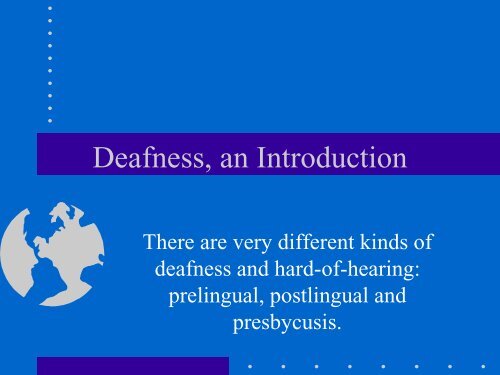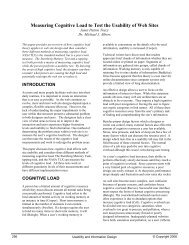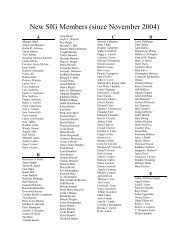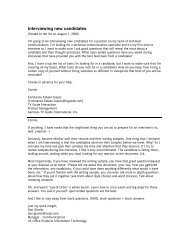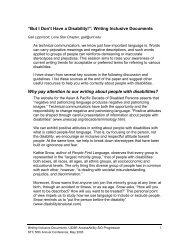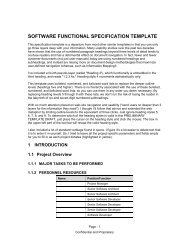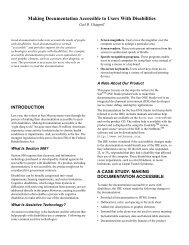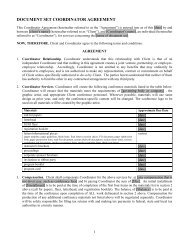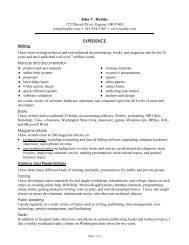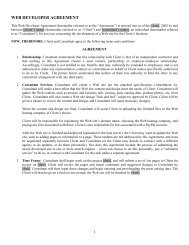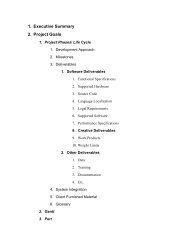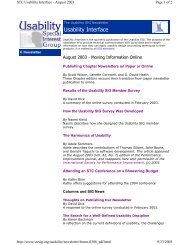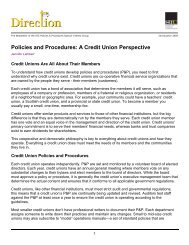Deafness, an Introduction
Deafness, an Introduction
Deafness, an Introduction
You also want an ePaper? Increase the reach of your titles
YUMPU automatically turns print PDFs into web optimized ePapers that Google loves.
<strong>Deafness</strong>, <strong>an</strong> <strong>Introduction</strong><br />
There are very different kinds of<br />
deafness <strong>an</strong>d hard-of-hearing:<br />
prelingual, postlingual <strong>an</strong>d<br />
presbycusis.
Kinds of <strong>Deafness</strong><br />
• Prelingual deafness is deafness which<br />
occurs before learning the spoken l<strong>an</strong>guage<br />
of one’s environment vs. postlingual.<br />
• The boundary between deafness <strong>an</strong>d hardof-hearing<br />
is often said to be < or > 70dB.<br />
• Presbycusis is the onset of deafness in older<br />
life.
Kinds of <strong>Deafness</strong><br />
Prelingual<br />
Postlingual<br />
Presbycusis<br />
<strong>Deafness</strong><br />
70dB loss in old<br />
age
<strong>Deafness</strong><br />
CHARACTERISTICS OF<br />
KINDS OF DEAFNESS<br />
• Prelingual <strong>Deafness</strong><br />
• Prelingual Hard-of-Hearing<br />
• Postlingual <strong>Deafness</strong> & Hard-of-Hearing<br />
• Presbycusis
<strong>Deafness</strong><br />
CHARACTERISTICS OF<br />
KINDS OF DEAFNESS<br />
• Prelingual <strong>Deafness</strong><br />
• Prelingual Hard-of-Hearing<br />
• Postlingual <strong>Deafness</strong> & Hard-of-Hearing<br />
• Presbycusis
Prelingual <strong>Deafness</strong>:<br />
a Definition<br />
Prelingual <strong>Deafness</strong>, for the purposes of this discussion,<br />
me<strong>an</strong>s deafness in persons whose onset was<br />
before they learned the l<strong>an</strong>guage of their environment.<br />
People generally learn their first l<strong>an</strong>guage<br />
well before age five, i.e., persons who were either<br />
deaf at birth (congenital deafness) or who became<br />
deaf from disease or accident (adventitious<br />
deafness) prior to developing the basics of the<br />
grammar of the l<strong>an</strong>guage of their environment.
Prelingual <strong>Deafness</strong>:<br />
Characteristics<br />
People with normal hearing generally learn the<br />
l<strong>an</strong>guage of their environment, be it English,<br />
Germ<strong>an</strong> or Chinese. M<strong>an</strong>y researchers believe<br />
that during the first several years of life, hum<strong>an</strong><br />
brains are open to original l<strong>an</strong>guage learning.<br />
Later, this open period ends. When this opportunity<br />
for learning is closed by deafness during<br />
this critical period, l<strong>an</strong>guage learning does not<br />
occur in the usual way.
Prelingual <strong>Deafness</strong>:<br />
Characteristics<br />
Thus, when a person is prelingually deaf, they<br />
learn a spoken l<strong>an</strong>guage mainly through <strong>an</strong><br />
artificial me<strong>an</strong>s, i.e., reading. Because print<br />
does not convey as much l<strong>an</strong>guage information<br />
that sound conveys, prelingually deaf<br />
persons are deprived of auditory l<strong>an</strong>guage<br />
input. The result is diminished reading <strong>an</strong>d<br />
writing skills. A few examples follow to<br />
clarify this.
Prelingual <strong>Deafness</strong>:<br />
Examples of Print Confusion<br />
• Ed <strong>an</strong>d Joy read books. Only context will<br />
tell the reader if the verb read or read is<br />
past or present. Consider bet, hit <strong>an</strong>d put which<br />
are past <strong>an</strong>d present verbs <strong>an</strong>d occasionally nouns.<br />
• Jo went to *church, Joe went to a church,<br />
Fr<strong>an</strong>ces goes to <strong>an</strong> old church, <strong>an</strong>d Fr<strong>an</strong>cis<br />
goes to the First Presbyteri<strong>an</strong> Church.<br />
Without hearing there is confusion involving both<br />
articles (a, <strong>an</strong>, the, <strong>an</strong>d *NULL) <strong>an</strong>d names.
Prelingual <strong>Deafness</strong>:<br />
Characteristics<br />
Reading tests show that<br />
prelingually deaf persons<br />
achieve <strong>an</strong> average<br />
of grade-4 reading<br />
skills by age 19. 1<br />
1<br />
R. Trybus & M. Karchmer, “School<br />
Achievement Scores of Hearing<br />
Impaired Children,” Americ<strong>an</strong><br />
Annals of the Deaf, 122:2, 62--69,<br />
Apr.1977.<br />
Writing tests are more<br />
difficult to st<strong>an</strong>dardize<br />
th<strong>an</strong> reading tests.<br />
The <strong>an</strong>omalous l<strong>an</strong>guage<br />
shown by prelingually<br />
deaf students<br />
is well known to their<br />
teachers <strong>an</strong>d parents. 2<br />
2<br />
K.E.Cr<strong>an</strong>dall, “An Investigation of<br />
Variables of Instruction …”<br />
Americ<strong>an</strong> Annals of the Deaf,<br />
125:3, 427--34, May 1980.
<strong>Deafness</strong><br />
CHARACTERISTICS OF<br />
KINDS OF DEAFNESS<br />
• Prelingual <strong>Deafness</strong><br />
• Prelingual Hard-of-Hearing<br />
• Postlingual <strong>Deafness</strong> & Hard-of-Hearing<br />
• Presbycusis
<strong>Deafness</strong><br />
CHARACTERISTICS OF<br />
KINDS OF DEAFNESS<br />
• Prelingual <strong>Deafness</strong><br />
• Prelingual Hard-of-Hearing<br />
• Postlingual <strong>Deafness</strong> & Hard-of-Hearing<br />
• Presbycusis
Prelingual Hard-of-Hearing:<br />
a Definition<br />
Prelingual Hard-of-Hearing, for the purposes of<br />
this discussion, me<strong>an</strong>s partial deafness in persons<br />
whose onset was before they learned the l<strong>an</strong>guage<br />
of their environment. People generally learn their<br />
first l<strong>an</strong>guage well before age five, i.e., persons<br />
who were either hard-of-hearing at birth (congenital<br />
hard-of-hearing) or who became hard-of-hearing<br />
from disease or accident prior to developing<br />
the basics of the grammar of the l<strong>an</strong>guage of their<br />
environment.
Prelingual Hard-of-Hearing:<br />
Characteristics<br />
Thus, when a person is prelingually hard-ofhearing,<br />
they learn a spoken l<strong>an</strong>guage<br />
imperfectly. Because hard-of-hearing<br />
babies have partial hearing, their impairment<br />
is often goes undetected for some<br />
time. This is in contrast to deaf babies<br />
whose deafness is usually recognized<br />
quickly.
Prelingual Hard-of-Hearing:<br />
Characteristics<br />
Thus, when a person is prelingually hard-ofhearing,<br />
they learn the spoken l<strong>an</strong>guage of<br />
their environment imperfectly. They have<br />
the Hercule<strong>an</strong> task of learning their first<br />
l<strong>an</strong>guage by combining imperfectly heard<br />
sound with print <strong>an</strong>d lip movements to<br />
assemble a knowledge of a l<strong>an</strong>guage.
Prelingual Hard-of-Hearing:<br />
Characteristics<br />
Because print does not convey as much of the<br />
l<strong>an</strong>guage information that sound conveys,<br />
hard-of-hearing persons are deprived of<br />
normal l<strong>an</strong>guage input. The result is<br />
diminished reading <strong>an</strong>d writing skills.
<strong>Deafness</strong><br />
CHARACTERISTICS OF<br />
KINDS OF DEAFNESS<br />
• Prelingual <strong>Deafness</strong> <strong>an</strong>d<br />
• Prelingual Hard-of-Hearing<br />
• Postlingual <strong>Deafness</strong> & Hard-of-Hearing<br />
• Presbycusis
Prelingual <strong>Deafness</strong>:<br />
Characteristics<br />
The l<strong>an</strong>guage skills of the vast majority of<br />
prelingually deaf <strong>an</strong>d hard-of-hearing<br />
persons generally preclude them from<br />
working as technical communicators.<br />
When STC members write for the general<br />
public, they should be mindful of the<br />
reading limitations of all their readers<br />
including all those with impaired l<strong>an</strong>guage<br />
owing to hearing loss.
<strong>Deafness</strong><br />
CHARACTERISTICS OF<br />
KINDS OF DEAFNESS<br />
• Prelingual <strong>Deafness</strong><br />
• Prelingual Hard-of-Hearing<br />
• Postlingual <strong>Deafness</strong> & Hard-of-Hearing<br />
• Presbycusis
Postlingual <strong>Deafness</strong><br />
• Postlingually deaf persons have <strong>an</strong> aural/<br />
oral communication problem, not a<br />
l<strong>an</strong>guage problem. Depending upon the age<br />
they lost their hearing, their reading <strong>an</strong>d<br />
writing skills are similar hearing persons,<br />
but with a bit of a delay in new idioms of<br />
the l<strong>an</strong>guage. Hearing aids <strong>an</strong>d speechreading<br />
instruction are often very beneficial.
<strong>Deafness</strong><br />
CHARACTERISTICS OF<br />
KINDS OF DEAFNESS<br />
• Prelingual <strong>Deafness</strong><br />
• Prelingual Hard-of-Hearing<br />
• Postlingual <strong>Deafness</strong> & Hard-of-Hearing<br />
• Presbycusis
Presbycusis<br />
• M<strong>an</strong>y people develop hearing loss as they<br />
approach old age. The cause is often<br />
unknown, but it is often genetic or<br />
adventitious, i. e., deafness often runs in<br />
families, or c<strong>an</strong> result from insult to the<br />
hearing system by environmental sound.<br />
• Like postlingual deafness, presbycusis is a<br />
communication problem, not a l<strong>an</strong>guage<br />
problem.
<strong>Deafness</strong>, <strong>an</strong> <strong>Introduction</strong><br />
Andrew Malcolm, Asso. Prof.<br />
National Technical Institute for the Deaf<br />
at the Rochester Institute of Technology<br />
Rochester, New York<br />
[716] 475-6332, voice & TDD<br />
a0mnce@rit<br />
rit.edu<br />
http://www.rit<br />
rit.edu~a0mnce


